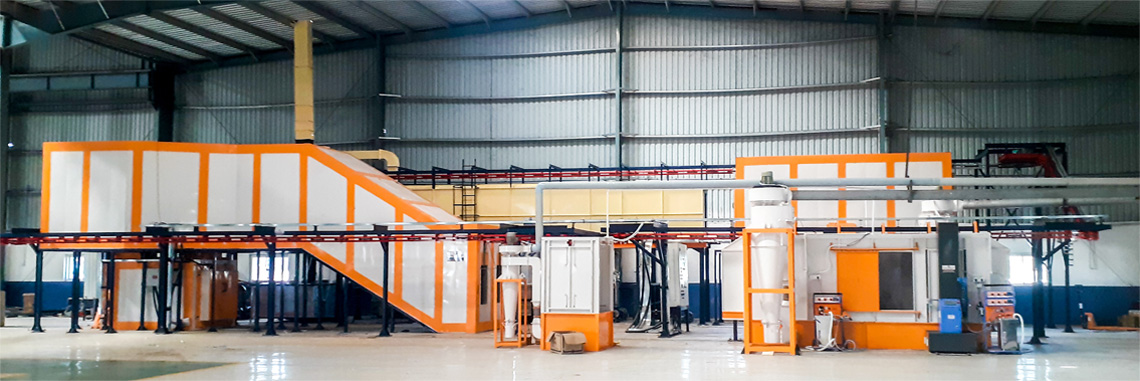
Understanding The Technology Behind Automatic Powder Coating
Read Count : 203
Category : Blogs
Sub Category : Miscellaneous
Powder coating is a dry finishing method that uses a powdered polymer-based material to cover a surface and fix it under heat. This makes a long-lasting finish that is used in many fields. Automatic powder coating systems are very important in modern manufacturing because they make things more efficient, cut down on waste, and make sure that the same results are always achieved. This piece talks about the basic ideas behind powder coating, how automation works, the most important parts of automatic systems, common problems, and new ideas that will shape the future of this important industrial process. The Basics of Powder Coating Powder coating is a process that starts with pre-treatment to clean and prepare surfaces. Next, an electric gun is used to apply powder. When you heat the powder in an oven, it forms a protected layer chemically. Powder coats come in two different types: thermoselective and thermoplastic. Thermoset coatings last a long time, and thermoplastic coatings melt and harden without changing the chemicals. Powder coatings have many benefits, such as low or no VOC pollution, higher transfer efficiency, thicker coatings with fewer flaws, and safety for the environment. The Role of Automation in Powder Coating Automation means using machines and software to do work with little help from a person, like powder coating. For accurate, repeatable application methods, it makes sure. Automatic powder coating systems, which have spray booths, robotic arms, reciprocators, conveyor lines, and built-in control units, handle the coating process's flow, timing, and accuracy. Better throughput, less human error, accurate powder use, cost and material savings, and higher operator safety are some of the benefits. A well-executed powder coating installation enhances surface durability and provides a smooth, long-lasting finish for metal components. Key Components of Automatic Powder Coating Systems Powder delivery systems make sure that guns always have the right amount of powder. Electrostatic spray guns break up and charge powder particles so that they stick well to grounded parts. Curing ovens heat parts that have been covered and harden the powder into a strong finish. Modern systems use PLC and SCADA interfaces to manage timing, part detection, spray parameters, and line speed. This lets changes and tracking happen in real-time. The Powder Coating Process in Detail As a first step in the powder coating process, bases are cleaned, phosphated, rinsed, and dried to make sure they will stick well and not rust. Robotic arms or reciprocators use sensors and 3D scanning to apply a uniform layer of powder to complicated parts in the best way possible. For long-lasting toughness, chemical resistance, and mechanical strength, make sure the coating cures properly. To check the quality, look at the coating's thickness, do tests for adhesion and impact resistance, and measure the gloss and colour matching. Innovations in Automatic Powder Coating Technology Spray technology has come a long way, with new features like multi-axis robotic arms, gun tips that clean themselves, and adaptable nozzles. Powder paints that are good for the environment use bio-based resins, non-toxic pigments, and low-temperature cure powders. Smart sensors for powder flow, remote diagnosis, predictive maintenance, and data-driven analytics for performance optimisation are all parts of Industry 4.0 and the Internet of Things (IoT). Challenges in Automatic Powder Coating Powder deposition problems often include uneven powder deposition, poor bonding from not properly treating the surface, and broken equipment. Part detection, different spray patterns, regular maintenance, gun calibration, and strict adherence to pre-treatment procedures are some of the solutions. Maintenance and training are important for learning how systems work, fixing problems, and making sure they are always available. Applications of Automatic Powder Coating Coating is useful for the automotive, consumer goods, building, and industrial machinery industries. Bicycle frames, aluminium window frames, electricity cabinets, and home furniture are all things that are often coated. A German HVAC company put in place an automatic powder coating system that cut the time it took to coat by 40% and the amount of work that had to be redone by 75%. Future Trends in Powder Coating Technology More AI-based control systems, flexible coating lines, and low-temperature and UV-cured powders are being used in coating technology as it develops. New technologies in an automatic powder coating include robots that can work on their own, programs for machine learning, and digital twins that can be used to simulate how coatings behave. Concerns for the environment and sustainability include curing stoves that use less energy, closed-loop powder recovery systems, and changes to the rules for technologies that don't use water or VOCs. Final Thoughts Automatic powder coating technology is important for modern production because it uses advanced chemistry, mechanics, and software to make a finishing process that is quick, clean, and long-lasting. We will see smart systems, green innovations, and better process integration in automatic powder coating as the need for quality and efficiency grows. If you want to automate your finishing line, look at your current system and talk to automation experts. This will help you make the first step towards a future that is more efficient and saves you money.
Comments
- No Comments

